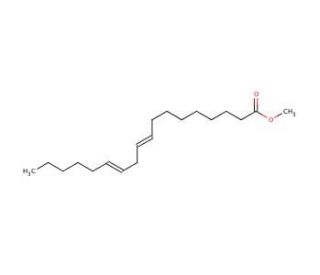

Methyl linolelaidate (CAS 2566-97-4)
QUICK LINKS
Methyl linolelaidate, with the CAS number 2566-97-4, is a methyl ester derivative of linolelaidic acid, which itself is a trans isomer of the essential fatty acid linoleic acid. This chemical structure comprises a long-chain fatty acid with two trans double bonds, which are esterified with methanol at the carboxyl end, enhancing its solubility in organic solvents compared to its free acid form. In research settings, methyl linolelaidate is particularly useful for studying the effects of trans fatty acids in various experimental systems. Its ability to integrate into lipid membranes allows researchers to investigate how the trans configuration of double bonds affects the physical properties of lipids, such as membrane fluidity and phase behavior. Additionally, methyl linolelaidate serves as a model compound in the study of lipid oxidation processes because the presence of trans double bonds can influence the rate and nature of lipid peroxidation. This aspect is crucial for understanding the stability and degradation of lipids under various conditions, which has implications for both food science and industrial applications. Moreover, the ester form of this fatty acid is often used in the synthesis of lipid-based materials, where the manipulation of lipid structures is needed to tailor material properties for specific uses.
Methyl linolelaidate (CAS 2566-97-4) References
- Selective oxidation reactions of natural compounds with hydrogen peroxide mediated by methyltrioxorhenium. | Amato, ME., et al. 2013. Molecules. 18: 13754-68. PMID: 24213654
- Efficient production of fatty acid methyl esters by a wastewater-isolated microalgae-yeast co-culture. | Suastes-Rivas, JK., et al. 2020. Environ Sci Pollut Res Int. 27: 28490-28499. PMID: 31845266
- Biochemical Profile by GC-MS of Fungal Biomass Produced from the Ascospores of Tirmania nivea as a Natural Renewable Resource. | Khaled, JM., et al. 2021. J Fungi (Basel). 7: PMID: 34947065
- The Dynamic Change in Fatty Acids during the Postharvest Process of Oolong Tea Production. | Zhou, ZW., et al. 2022. Molecules. 27: PMID: 35807544
- Salt Stress Induces Changes in Physiological Characteristics, Bioactive Constituents, and Antioxidants in Kenaf (Hibiscus cannabinus L.). | Birhanie, ZM., et al. 2022. Antioxidants (Basel). 11: PMID: 36290728
- Melanogenesis Inhibitory Activity, Chemical Components and Molecular Docking Studies of Prunus cerasoides Buch.-Ham. D. Don. Flowers. | Kooltheat, N., et al. 2023. J Evid Based Integr Med. 28: 2515690X231152928. PMID: 36740925
- Nigella sativa as an antibiotic alternative to promote growth and enhance health of broilers challenged with Eimeria maxima and Clostridium perfringens. | Manjunatha, V., et al. 2023. Poult Sci. 102: 102831. PMID: 37356299
- Dense Cover, but Not Allelopathic Potential, of Naturalized Alien Cenchrus echinatus L. Threatens the Native Species in Urban Vegetation. | Hassan, MO., et al. 2023. Plants (Basel). 12: PMID: 37960091
- New insights into changing honey bee (Apis mellifera) immunity molecules pattern and fatty acid esters, in responses to Ascosphaera apis infection. | Elhoseny, MMM., et al. 2024. J Invertebr Pathol. 202: 108028. PMID: 38065241
- Chemical Constituents and in vitro Antibacterial Activity of Fixed Oils from Different Parts of Bridelia stipularis (L.) Blume. | Rahman, S., et al. 2023. Pak J Biol Sci. 26: 549-556. PMID: 38193369
Ordering Information
| Product Name | Catalog # | UNIT | Price | Qty | FAVORITES | |
Methyl linolelaidate, 100 mg | sc-215356 | 100 mg | $48.00 |
